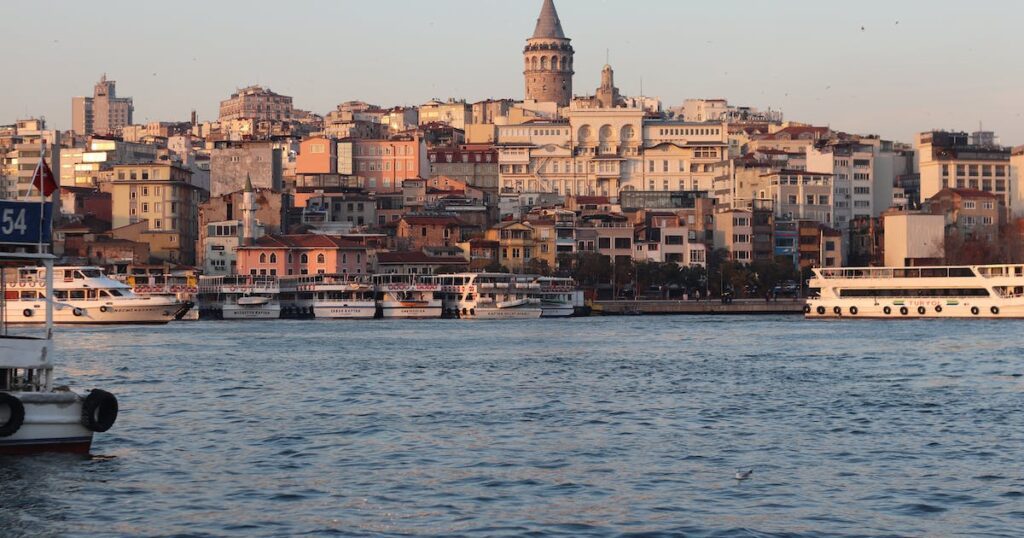1. Hagia Sophia Mosque (Aya Sofya)
Renowned as one of the most beautiful buildings in the world, the charming Byzantine glory of the Hagia Sophia (Aya Sofya) is not only one of the best things to do in Istanbul, but in all of Turkey.
Built by the Byzantine emperor Justinian in 537 AD, it is renowned as the greatest architectural achievement of the Byzantine Empire and remained the largest church in the world for 1,000 years.
The astonishing thickness of its exterior is bordered by the delicate minarets added after the Ottoman conquest, while the sumptuous and cavernous frescoed interior is a great reminder of the power and might of ancient Constantinople.
2. Ephesus
You should not miss this point on the list of the best tourist attractions in Turkey. The mighty ruins of Ephesus is a city of colossal monuments and roads with marble columns.
One of the most complete and still famous ancient cities in the Mediterranean region, this is the place to experience what life must have been like during the golden age of the Roman Empire.
The city’s history dates back to the 10th century BC, but the major monuments you see today date back to its Roman era, when it was a thriving commercial center.
In particular, the Library of Celsus, the complex of terraced houses with frescoes and the Great Theater all show the wealth and importance of Ephesus in the Roman period.
A sightseeing trip here will take at least half a day to cover the main attractions and more if you really want to explore, so make sure you plan your visit so you don’t feel rushed.
3. Cappadocia
The surreal and sloping rock valleys of Cappadocia are every photographer’s dream. Rock crests and hilltops host undulating wave-like rock panoramas or crazy-shaped peaks that have been formed by millennia of wind and water action.
And if you don’t feel like hiking for the views, this is one of the top destinations in the world for a hot air balloon ride.
Nestled in this unique landscape, similar to the moon, are the churches cut in the stone with frescoes and the architecture cut in the cave from the Byzantine era, when this area was the home of monastic Christian communities.
In particular, the multiple cave churches in the Goreme Open Air Museum and Valea Ihlara host some of the best surviving examples of religious art from the Middle Byzantine period in the world.
Cappadocia’s villages, half cut into the hills where travelers base themselves to explore the surrounding countryside, are also an attraction in themselves, with their boutique hotels that let you sleep in a cave in comfort contemporary.
4. Topkapi Palace
Sumptuous beyond all belief, the Topkapi Palace in Istanbul will take you to the fantastic and opulent world of the sultans.
From here, in the 15th and 16th centuries, the sultans of the Ottoman era built an empire that would expand in Europe and down through the Middle East and Africa.
The interiors, with their exuberantly decadent tiling and lavishly bejeweled decor, are an unforgettable glimpse into the base of Ottoman power.
In particular, do not miss the building of the Imperial Council, where the affairs of the empire were managed by the Grand Vizier; the collection of weapons exhibited in the Imperial Treasury; the world-class collection of miniature paintings; and the dazzling Harem Rooms, which were designed by the renowned Ottoman architect Sinan.
The surrounding public gardens were once the only domain of the Royal Court, but now they are open to the public and offer a quiet and green respite from the city streets.
5. Pamukkale
One of the most famous wonders of Turkey, the pure white travertine terraces of Pamukkale (“Cotton Castle” in English) cascade down the slope looking like a snow field displaced in the middle of the green landscape.
Although the travertines are themselves a highlight of a trip to Turkey, the vast and battered ruins of the Greco-Roman Hierapolis, an ancient spa town, lie scattered on top of this calcite hill.
After exploring the ancient theater, with its views over the countryside and the remains of the agora, the gymnasium, the necropolis and the great gates of the city, you can swim in the mineral-rich waters that made this ancient spa town famous, in the ancient pool. .
Afterwards, descend the travertine hill, walking through the pools of water on the upper terraces, to the small modern village of Pamukkale below.
For the best photos, come at dusk, when the travertines glow as the sun sinks below the horizon.
6. Picturesque Antalya
This lively Mediterranean center has something for everyone. The two main beaches outside the city attract tourists from all over Europe. While the old town area, comfortably right in the center of the city, with its cobbled lanes surrounded by crumbling Ottoman-era mansions, is a wonderful place to explore.
The Antalya Museum is renowned as one of the best in the country, with an amazing collection of Hellenistic and Roman marble statuary, and there are plenty of attractions outside the city for travelers wishing to use Antalya as a base.
7. Cruise in the Mediterranean Sea
Turkey’s Mediterranean coast has ruins galore and plenty of things to do, but for many people, it’s all about soaking up the sun while enjoying the gorgeous coastal views.
Yachting is the number one activity for visitors to Bodrum and Fethiye for good reason. Steep slopes clothed in forest, hidden bays with tiny white sand beaches and hundreds of scattered islands are the perfect place to explore by sea. Even those in love with land will be impressed.
One of the most famous trips is known as the Blue Cruise and travels from Fethiye to the south, along the coast, until landing near Mount Olympus, where the famous natural phenomenon of the chimera is located.
8. Mount Nemrut
The most important tourist attraction card for eastern Turkey, the burial mound at the top of Mount Nemrut is scattered with the broken remains of mammoth statues that guarded it.
This strange and lonely place has to be one of the strangest archaeological sites in Turkey. The huge stone heads of long-forgotten gods look down from the summit, casting an eerie atmosphere over the barren peak of the mountain.
The construction works of the peak are the work of Antiochus I, the ruler of the Kingdom of Commagene, which is located here, in the buffer region between the Roman and Parthian empires.
Antiochus I dedicated this great burial mound to himself as a showcase of his importance, erecting an artificial peak 50 meters high on the top of Mount Nemrut and then adorning it with statues of himself and various gods.
The most popular time to visit is at sunrise, so you can watch the statues as they emerge from the darkness.
9. Oludeniz
The water is an impossibly blue-turquoise. Check it out. Lush green forest that tumbles down a cliff to a white sand beach. Check it out. The sheltered outpost of Oludeniz, just a short trip from Fethiye, is Turkey’s most famous beach and, with scenery that might as well have fallen off a perfect postcard, it’s easy to see why its popularity it did not decrease.
If the beach gets too crowded, it’s time to take to the skies and experience the amazing aerial views in a tandem paraglider dive from the peak of the mighty Babadag (Baba Mountain), which rises behind the shore.
10. Aspendos
Just south of the resort town of Antalya, the stunning massive mammoth of the Roman Theater of Aspendos celebrates the pomp and ceremony of the reign of Marcus Aurelius.
Considered the best surviving example of a classical-era theater still standing in the world, the highly restored 15,000-seat theater is one of the star attractions of antiquity.
There are remains of an aqueduct, agora, stadium and a basilica from the Byzantine era, all scattered on the vast hilly area that surrounds the theater.


I’m Djavan Dias, or DJ for short. I’ve swapped corporate life for endless adventures, sharing travel tips and insights on Premier Wanderlust. Dive into a world of smart travel and unforgettable experiences with me!



